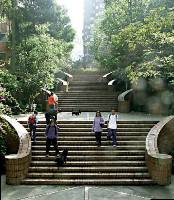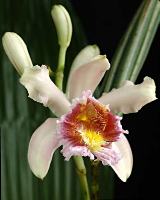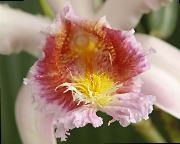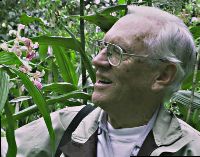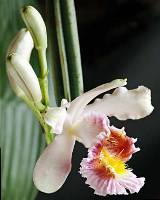 |
A New Orchid Discovered in the Asphalt Jungle Click images to enlarge |
|
The discovery of a new orchid is a task that day-by-day becomes more difficult. Orchids have been mentioned in Indian literature as far back as 1,500 years BC. In China orchids were well known before Confucius and in Ancient Greece Theophrastus and Dioscorides paid them attention.
What is amazing is that in this time and place there are still orchids that have not been yet classified, and many others that have not been properly described following the strict rules of taxonomy and scientific nomenclature at the time of their discovery and therefore their names are not accepted.
Eric Hansen in his thrilling book Orchid Fever recounts his travels in search of strange orchids with natives in the jungle of Borneo:
"Earlier that day, I had entered the Borneo rain forest in search of wild orchids. The morning mist was still rising and the dawn bird chorus had just faded as Tiong, a government plant collector, and two of his helpers paused at the base of a limestone cliff to burn joss sticks and stacks of Chinese devotional money. These offerings were intended to appease the spirit word before we started our climb. Everything began well enough, but by midday the mountain spirits responded to our presence. Tiong was near the top of a tree when he reached up and gripped a Wragler's pit viper sleeping on a branch. Within moments, my guide and protector was hurtling through space with two fang marks in the back of his hand. We didn't find the orchids we were looking for, and we spent the rest of the afternoon trying to get Tiong off the mountain."
Our adventure was completely innocuous, not dangerous at all, more urban, with no risks, excitement or vipers, but maybe even more extraordinary. We have already noted that it is very unusual to find a new species, but to find one in the midst of a heavily populated city, in the core of its downtown, in what the gringos called the asphalt jungle is almost impossible and the more unexpected since this plant has been for the past thirty years exposed to public view, a few inches from the cement and yet it remained unseen.
The first homage should be rendered to Rogelio Salmona, a lover of plants and a distinguished architect in Bogotá, who brought from the Tequendama zone the species object of our study and proceeded to transplant it in the gardens, also of his design, that surround his masterwork las Torres del Parque. This residential high rise community in the center of Bogotá, has as an added feature, besides the particular and beautiful architectural design of its buildings: the fact that its residents chose not to turn this project and gardens into an unsympathetic closed space, but opened its paths for the delight and enjoyment of all people.
It was while walking in the gardens that surround these living steps, by which an inscription quotes Jorge Zalamea´s poem The dream of the stairs, "Oh, believers of lowly circumstances, of voluble memory and uncertain will, the first fiscal requirement of this court is your scornful ignorance and the definitive exile of that horde that pretends to resemble men." that I, whose main occupation is to look and see, a kind of voyeur, focused my eyes on this plant, obviously an orchid in bloom. This was a Sobralia, an orchid species famous for being the tallest orchid plant of all. The Sobralia altissima from Perú reaches a height or more than 40 feet. Our plant in question reaches a more modest height, a mere 19 feet.
"Hi Guillermo,
"Many thanks for the pictures. It seems to be Sobralia cattleya, from Colombia and Venezuela. In the picture it looks almost white, usually it shows more color, from pink to a medium shade of coffee. Take a look at my web page
http://sobralia.autrevie.com/Sobralia_cattleya.html
"Best regards,
"Nina"
Two hours later, on the same day, November 6th, 2003, Nina e-mailed me again:
"Hi Guillermo,
"I was wrong, the plant is not Sobralia cattleya. Better yet I believe it to be Sobralia dichotoma. Please see my web page:
http://sobralia.autrevie.com/Sobralia_dichotoma.html
'I've placed your photo there. There's a similar picture in Orquídeas Nativas de Colombia, Volume 4, p. 539.
"Greetings,
"Nina"
In the meanwhile Father Ortiz had been able to fix his e-mail
and miraculously received my photo of the Sobralia (after
some unsuccessful attempts) and told me he believed it was neither
S. cattleya nor S. dichotoma, which happens to
be very colorful and a native of Perú. What then is our
orchid? He answered back that José Celestino Mutis, director
of the Colombian Royal Botanical Expedition (1783-1816) ordered
it drawn (with no attempt at classification) before Ruíz
and Pavón (of the Botanical Expedition to Perú
and Chile) had established the genus. It was later when someone
erroneously called our species Sobralia dichotoma, probably
from a hint given by Charles Schweinfurth, an authority on native
Peruvian orchid species. This icon can be found in the first
of the five volumes on orchids of the Botanical Expedition. This
is the origin of the error in classification of this plant later
found in Orquídeas Nativas de Colombia.
It was then that we decided to go and search for it in its natural
habitat, which Father Ortiz had perfectly localized in his memory.
Enrique Uribe, former director of the Jardín Botánico
de Bogotá, and a generous patron of new Botanical Expeditions,
led the way in the search for this orchid plant, in the region
that Father Ortiz, our resident orchid expert, remembered as
well as he remembered its exact flowering date. The journey was
planned for the next Sunday and Father Ortiz said, "I will
celebrate mass at eight o'clock in the morning, thus call for
me at eight thirty and if the weather is sunny we will go hunting."
That Sunday the weather was not promising but the absence of rain was enough for us to decide to make the journey. We set out towards San Antonio de Tequendama and as we reached a height above sea level of 9,000 feet we started to see the sought orchid plant in full flower. Unfortunately all plants were well protected from intruders by high and inaccessible cliffs. Later we came across some more accessible specimens, collected a few plants for the Botanical Garden and were able to photograph in situ the flowers of this Sobralia.
And from now on, the plant is a new species named Sobralia mutisii in honor of José Celestino Mutis, the other botanist-priest who chanced to see it 200 years before.
Translated by Juli Carbonell
Guillermo's Image Galleries
Index of Orchid Images
